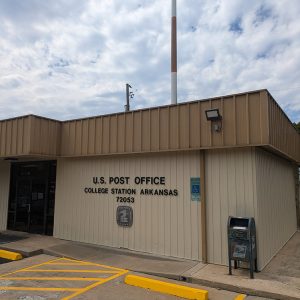calsfoundation@cals.org
College Station (Pulaski County)
College Station, Genevia, and Bucktown are names used locally to identify the U.S. Census Designated Place located around Frazier Pike in Badgett Township in the southeastern area of Pulaski County.
William Thompson and L. B. Porter produced a manuscript in 2009 that states the area was once called Motley Heights in the late 1890s and early 1900s, but different names for the area seem to have been used concurrently. The Arkansas Gazette, on August 23, 1908, advertised a “Big Republican Mass Meeting & Barbecue” in the College Park Addition, described as a beautiful suburb to Little Rock (Pulaski County). There were 400 lots to be sold at prices from $25 to $115. The location is described as a thirty-minute drive from the Old State House, six blocks from where the Rock Island Railway was expected to erect terminals, two blocks from College Station (perhaps referencing an actual building), and a half mile from Consumer’s Oil Mill. Further instructions on how to reach College Park advise the public to take the “Valley train” that left Little Rock at 8:00 a.m. and exit at the College Station or take the streetcar to the foot of East Ninth Street, and vehicles would carry people to the College Park site.
An advertisement in the Arkansas Democrat dated May 9, 1909, shows an event named “Grand Picnic Free Barbecue” encouraging attendance and the purchase of property by “colored people” in the area named Motley Heights Addition. The advertisement also proclaims that the area would become the future “colored section” of Little Rock. Early surnames in the community include Frazier, Doyne, Porter, Phillips, White, Walker, Banks, King, Keown, Thompson, Simmons, and Bankhead.
Local newspapers covered happenings and crimes in the area, like the mysterious shooting death of Ward Turner, a carpenter who was discovered with multiple bullet wounds on Missouri Pacific tracks south of College Station in March 1921. The Arkansas Democrat published an advertisement on September 28, 1921, soliciting work for “Odd Painting” jobs by Isaac Hoskins of College Station. The announcement of the marriage between seventeen-year-old Roosevelt Prince and sixteen-year-old Mary Beatrice Wallace, both of College Station, was published on June 28, 1921. A 1922 article centered on Clarence Horton, whose repetitive crimes included the theft of a horse, a vehicle, and a flock of chickens while he was absent without leave from the county penal farm while serving as a trusty; he began this particular crime spree with the theft of a “crème colored 14-year-old mare and top buggy” from Antonia Franklin, who had borrowed the items from a neighbor in College Station.
College Station was also briefly named Genevia after Myrtle Genevia Jones. In fact, the name Genevia was used for the local post office in 1942. Myrtle Genevia Jones was born in England (Lonoke County) and lived in College Station with her husband, Jack Dorothro Jones, a grocer who worked in the Finance Division of the Works Progress Administration (WPA) in the early 1940s. The 1940 U.S. Census states her occupation as schoolteacher.
Bucktown is a name casually used to describe the area known as College Station. In the late 1940s through the early 1980s, it was a common reference to the strip of businesses along Frazier Pike that provided hot meals and entertainment.
College Station Elementary was the first school in the community for Black children. It was built in 1909. The Pulaski County Special School District absorbed the school around 1949. Otis Lee Walker served as principal from 1949 to 1963. Ads for the area’s Herron Hot Dog Shop, J. T. Thompson Taxi Company, Hadley’s Café & Service Station, and Fred Adkins Spot Café, along with various beauty and barber services, appear in the yearbooks of Dunbar Senior High School and J. C. Cook High School.
Several members of the community stand out as examples of excellence. Annie Mae Bankhead, as a founding member of the Progressive League of College Station in 1960, led efforts to form the College Station Head Start Program in 1965. She took the concerns of her community to the governor’s office and the office of the U.S. president. In 1970, the College Station Freedom School was launched as a protest against a local school system that was still refusing to desegregate. The Reverend Hezekiah David Stewart began his Arkansas service at Mount Nebo AME Church and expanded his service to establish the Watershed Human and Community Development Agency. A tornado struck the community in 1997, and Rev. Stewart was part of the delegation to greet President Bill Clinton when he toured the damaged area. Lisa Sparks Walker grew up in the area and is an inductee to the Arkansas Track and Field Hall of Fame.
For additional information:
“Big Republican Mass Meeting & Barbecue.” Arkansas Gazette, August 23, 1908, p. 7.
“Licensed to Wed.” Arkansas Gazette, June 28, 1921, p. 7.
“Mystery Shrouds Killing of Negro.” Arkansas Gazette, March 11, 1921, p. 16.
“Odd Painting Jobs.” Classified advertisement. Arkansas Democrat, September 28, 1921, p. 10.
“Slavish Devotion to a System Causes Downfall.” Arkansas Gazette, August 5, 1922, p. 18.
Thompson, William. Welcome to College Station, Pulaski County, Arkansas “A Community’s History.” N.p.: 2009.
Rhonda Stewart
CALS Butler Center for Arkansas Studies
 Bankhead Drive Street Sign
Bankhead Drive Street Sign  College Station's Ye Paul's Soul Bodega & Grill
College Station's Ye Paul's Soul Bodega & Grill  College Station Business Center
College Station Business Center  College Station Post Office
College Station Post Office  College Station Sign
College Station Sign  Pulaski County Map
Pulaski County Map 



Comments
No comments on this entry yet.